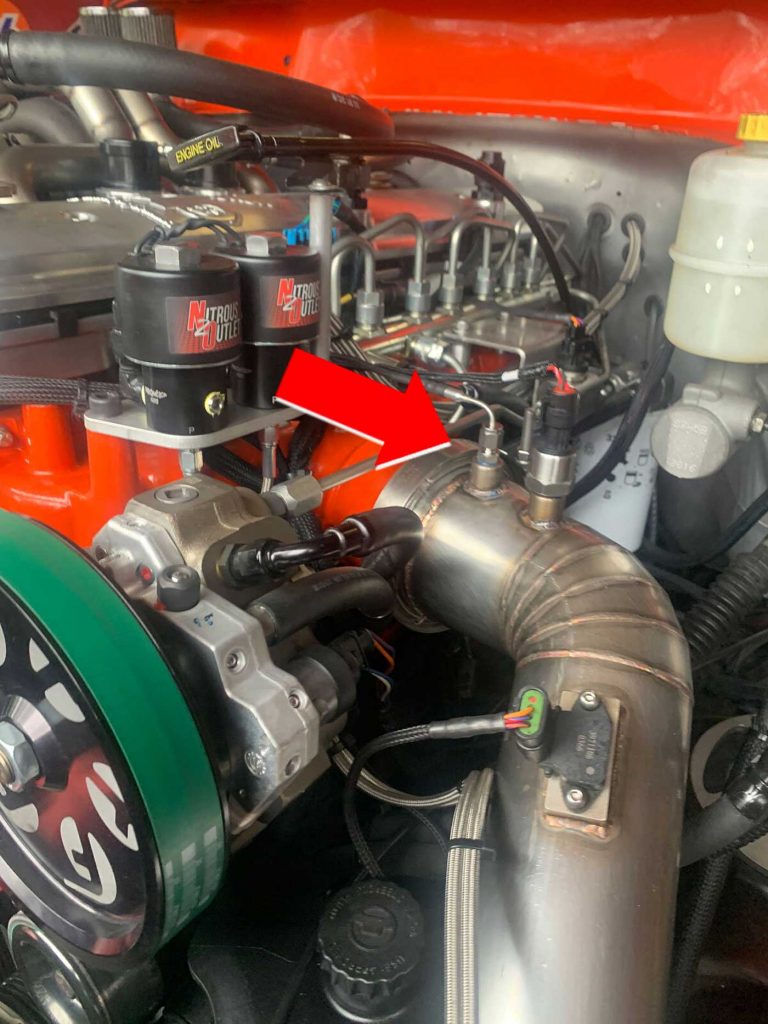Capital Diesel Performance
Ken Bruner, the owner of Capital Diesel Performance in Windsor, California, is preparing his 2006 RAM for AMSOIL’s Ultimate Callout Challenge. Held at Lucas Oil Raceway in Brownsburg, the massive three-day event runs from May 21-23 and is one of the ultimate annual gatherings for the competitive dyno, drag racing, and sled pulling.
Ken’s custom compound-turbocharged race-prepped truck has plenty of parameters to keep an eye on, but up until now, monitoring these temps, pressures, and speeds has been difficult at best. Frustrated, he turned to Banks. “My method for recording data was to record my analog gauges with a GoPro,” said Ken. “We reached out to Banks for their input on the ultimate data logging system, and they fixed us up with a pair of iDash DataMonsters and their sensor modules. With the new accurate data, I’ll be able to determine compressor map location, turbocharger efficiency, intercooler efficiency, mass airflow, air density and so much more.”
In order to win prize money at UCC, trucks must compete in all events. But these events are radically different and require unique tuning. Having this new data will allow Ken to dial in his system for each dyno, drag racing, and sled pulling.

The Capital Diesel Performance Setup
Ken explains his sensor setup from the nose of the truck to the twin iDash DataMonsters.
“We start with an AirMouse in the grille of the truck, giving us ambient pressure, temperature, and humidity, which combined equals ambient air density. Subtracting this number from our Manifold Air Density will tell us the amount we’ve lost or gained through the entire system. But where did we gain or lose air density and why? That’s the job of the other pressure and temperature sensors.
Starting with the air intake going to the primary turbo, we’re measuring air temp and air pressure. That’ll show me how restrictive the air filter is. With that pressure, I’ll be able to locate the turbo on the compressor map along with shaft speed, thanks to the Banks speed sensor installed in the compressor housing. Hopefully, we can get mass airflow from that turbo and figure out the pounds of air per minute for that turbocharger to see how hard we’re driving the primary turbo.
Moving to interstage we need pressure and temperature data to once again see where we are on the map, and just how much heat the first turbo has created. I think the data will show us that we’ll need intercooling between turbos.
Intercooler
Pre-intercooler readings will tell us where we are with the secondary turbo. Also, by having the temperature and pressure after the intercooler we’ll be able to tell how efficient the intercooler is and what the pressure drop is from the inlet to the outlet. We could always fog the front of the intercooler to cool its face of it, increasing the density output.
Post-intercooler temp and pressure readings are taken right at the intake manifold inlet. I’ll be able to see how the compound system does on its own and how it does with nitrous. Since the nitrous system is progressive we’ll be able to trace differences, too.
I’m looking at compressor speed on both turbos to know exactly where on the maps I am, and I’m monitoring exhaust and pressure coming out of the engine right out of the exhaust manifold. That tells me the EGT and turbine drive pressure.
The entire system is plug-and-play. It makes me so happy that don’t have to wire loom, crimp, and heat shrink every wire.” Take a look below to see a diagram of his system, and check out the links to see for yourself how amazingly useful the iDash and sensor module system really is.

Capital Diesel Performance Full List
Monitoring:
Two iDash DataMonster gauges
Modules used:
Three 5-Channel Analog w/Frequency and the AirMouse®
Sensors and location:
Ambient Conditions
• AirMouse
Airbox Outlet / Compressor Inlet Conditions
- Air Temp: compressor inlet #1
- Pressure: compressor inlet #1
- Analog EGT: compressor inlet #2
- Pressure: compressor inlet #2
- Frequency: turbo speed sensor #1
- Frequency: turbo speed sensor #2
Compressor Outlet / Intercooler Inlet Conditions
• Analog EGT: intercooler inlet
• Pressure: intercooler inlet
Exhaust Conditions
- Analog EGT: exhaust manifold
- Pressure: exhaust manifold
- Analog EGT: turbine inlet / intermediate stage
- Pressure: turbine inlet / intermediate stage
Manifold Conditions
- Analog EGT: exhaust manifold
- Pressure: intake manifold
Engine Speed (RPM)
- Hall Effect Speed Sensor


Intercooler and Manifold
Ken also added the race-proven Big Hoss Intake Manifold and the Banks intercooler for ’03-’07 5.9L Cummins-powered RAMs. The cast aluminum manifold was designed originally for the Sidewinder Dakota race program, which held the record for being the fastest diesel truck on the planet.


Ram-Air Rear Diff Cover
Although his rear differential won’t see the high temps normally associated with towing heavy loads, Ken figured he’d complete the Banks look and keep his gear oil as cool as possible.

By the time you read this, Ken will be halfway between Windsor, CA, and Brownsburg, Indiana headed to Ultimate Callout Challenge.

